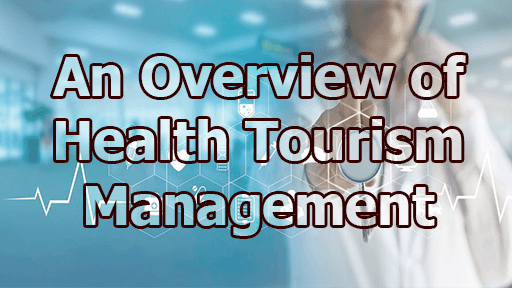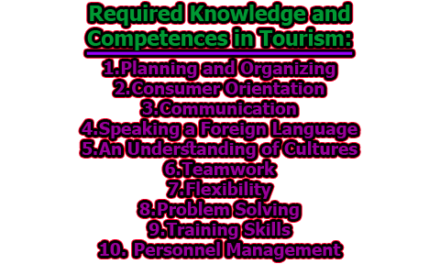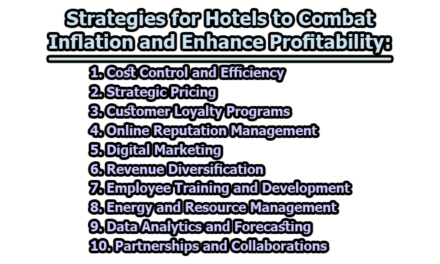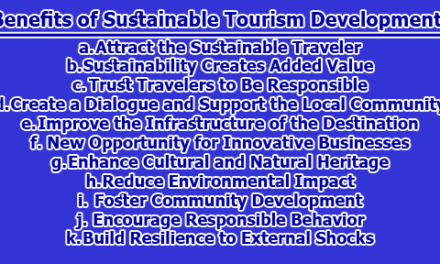An Overview of Health Tourism Management:
Health tourism management is a dynamic and rapidly evolving sector within the broader domain of medical and wellness tourism. It encompasses a wide spectrum of activities and services that cater to individuals seeking healthcare, wellness, or medical procedures in destinations beyond their home countries. The appeal of health tourism lies in its potential to offer cost-effective healthcare, access to specialized treatments, and the opportunity to combine medical care with leisure and relaxation. This article delves into an overview of health tourism management; the historical evolution of health tourism, its various types, factors driving its growth, management strategies, and future trends. By examining these aspects, we gain valuable insights into the multifaceted world of health tourism and its significance in the global healthcare landscape.
Section 1: Historical Evolution of Health Tourism:
1.1 Early Forms of Health Tourism: Early forms of health tourism can be traced back to ancient civilizations, where individuals sought healing and well-being by visiting specific locations known for their therapeutic properties. These early practices laid the foundation for the modern concept of health tourism.
- Ancient Greece and Roman Baths: The ancient Greeks and Romans developed a culture of bathing in natural mineral springs, which were believed to have healing properties. Locations like the Roman Baths in Bath, England, and the Asclepius temples in Greece attracted visitors seeking relief from various ailments (Cottrell, 2017).
- European Spa Towns: During the 18th and 19th centuries, European spa towns like Baden-Baden in Germany and Karlovy Vary in the Czech Republic became popular destinations for those seeking the therapeutic benefits of natural hot springs and mineral waters (Smith, 2018).
1.2 Key Milestones in the Development of Health Tourism: The development of health tourism as an industry underwent several significant milestones, shaping its growth and evolution over time.
- Emergence of Modern Medical Tourism: The modern concept of medical tourism began to take shape in the late 20th century, with patients traveling abroad for medical procedures, often to access more affordable healthcare or specialized treatments (Connell, 2006).
- The Rise of Cosmetic Surgery Tourism: In the early 21st century, countries like Thailand and Brazil gained prominence as destinations for cosmetic surgery tourism, attracting individuals seeking aesthetic procedures at lower costs (Alvarez-Perez et al., 2012).
- Wellness Tourism Movement: Wellness tourism gained momentum in the late 20th century, driven by a growing interest in holistic health and well-being. The emergence of destination spas and wellness retreats contributed to the diversification of health tourism (Smith & Puczkó, 2009).
1.3 Historical Trends and Shifts in Health Tourism Destinations: Health tourism destinations have evolved over time, influenced by changing healthcare standards, economic factors, and shifts in consumer preferences.
- Shift from the West to the East: In the early days of medical tourism, Western countries were popular destinations. However, the 21st century saw a shift toward Eastern destinations, such as India, Thailand, and Malaysia, offering competitive healthcare services (Lunt et al., 2016).
- Destination Diversity: The health tourism landscape has become increasingly diverse, encompassing not only traditional destinations but also emerging markets in South America, the Middle East, and Eastern Europe (Johnston et al., 2019).
- Integration with Tourism: Health tourism destinations have started to emphasize not only medical facilities but also tourism experiences, incorporating cultural, recreational, and wellness elements to attract a broader range of visitors (Page & Connell, 2006).
Section 2: Types of Health Tourism:
2.1 Medical Tourism:
2.1.1 Definition and Scope: Medical tourism involves individuals traveling across international borders to seek medical treatment or healthcare services that may not be readily available or affordable in their home countries. It encompasses a wide range of medical procedures, including elective surgeries, organ transplants, and specialized treatments (Connell, 2013).
2.1.2 Popular Medical Tourism Destinations: Popular medical tourism destinations vary by region, but some of the well-known countries include:
- Thailand: Known for its affordable healthcare and world-class medical facilities (Bonde, 2018).
- India: Offers a wide range of medical treatments, including cardiac surgery and orthopedic procedures (Johnston & Crooks, 2018).
- Mexico: Attracts patients from the United States for dental work, bariatric surgery, and cosmetic procedures (Ormond et al., 2017).
2.1.3 Common Medical Procedures Sought: Patients seek various medical procedures in medical tourism, including:
- Cosmetic surgery (e.g., breast augmentation, facelifts)
- Orthopedic surgeries (e.g., knee or hip replacements)
- Cardiac surgeries (e.g., bypass surgery)
- Fertility treatments (e.g., in vitro fertilization)
2.2 Wellness Tourism:
2.2.1 Definition and Scope: Wellness tourism focuses on promoting overall well-being, both physically and mentally, through holistic experiences and activities. It encompasses activities such as spa visits, yoga retreats, meditation, and wellness-focused vacations (Smith & Puczkó, 2009).
2.2.2 Wellness Tourism Destinations and Trends: Wellness tourism destinations are diverse and can range from luxury resorts in Bali to wellness retreats in the Swiss Alps. Recent trends include:
- Wellness resorts integrating technology for personalized health experiences (Ivanov et al., 2019).
- Wellness tourism in urban settings with wellness-focused city breaks (Sharpe et al., 2020).
2.2.3 Wellness Programs and Services: Wellness programs and services offered in wellness tourism destinations often include:
- Spa treatments (e.g., massages, facials)
- Yoga and meditation classes
- Healthy cuisine and nutrition counseling
- Mindfulness and stress management workshops
2.3 Dental Tourism:
2.3.1 Definition and Scope: Dental tourism involves individuals seeking dental care and treatments abroad, often due to cost savings or accessibility issues. Common dental procedures sought include dental implants, cosmetic dentistry, and dental surgeries (Eaton et al., 2013).
2.3.2 Dental Tourism Destinations and Treatments: Dental tourism destinations include:
- Hungary: Known for its dental clinics offering a wide range of services.
- Costa Rica: Attracts patients from North America for dental work due to lower costs (Bridget, 2018).
2.4 Spa Tourism:
2.4.1 Definition and Scope: Spa tourism focuses on relaxation, rejuvenation, and wellness through spa experiences. It often involves visits to dedicated spa resorts or day spas, offering a range of therapeutic treatments (Smith, 2018).
2.4.2 Spa Tourism Destinations and Offerings: Spa tourism destinations span the globe and can be found in:
- Bali: Known for its luxury spa resorts offering traditional Balinese treatments.
- Iceland: Offers unique geothermal spa experiences like the Blue Lagoon.
- Switzerland: Famous for wellness retreats in the Swiss Alps (Murray, 2018).
2.5 Alternative and Integrative Medicine Tourism:
2.5.1 Definition and Scope: Alternative and integrative medicine tourism involves seeking non-conventional healthcare treatments and therapies that emphasize holistic well-being. It often includes practices such as acupuncture, Ayurveda, and traditional Chinese medicine (Petersen et al., 2015).
2.5.2 Popular Alternative Medicine Practices: Popular alternative medicine practices include:
- Acupuncture: Originating from traditional Chinese medicine, it involves inserting thin needles into specific points on the body for therapeutic purposes.
- Ayurveda: An ancient Indian system of medicine that emphasizes balance and holistic healing.
- Traditional Chinese Medicine (TCM): Includes herbal medicine, acupuncture, and dietary therapy.
2.5.3 Destinations for Alternative Medicine Tourism: Destinations for alternative medicine tourism vary, with India, China, and Thailand being popular choices for practices like Ayurveda and TCM (Sharma et al., 2015).
Section 3: Factors Driving Health Tourism:
3.1 Cost-Effective Healthcare: Cost-effective healthcare is a significant driver of health tourism, as patients seek affordable treatment options compared to their home countries. This affordability is influenced by factors such as lower labor costs, reduced overheads, and currency exchange rates.
Research shows that patients from countries with high healthcare costs, such as the United States, are increasingly traveling to destinations like India and Thailand for medical procedures at a fraction of the cost (Ebrahim, 2018).
3.2 High-Quality Healthcare Facilities: High-quality healthcare facilities attract medical tourists looking for world-class treatment and advanced medical technologies. Accredited hospitals and clinics with international certifications play a vital role in this regard.
For example, Singapore’s Mount Elizabeth Hospital and Thailand’s Bumrungrad International Hospital are renowned for their top-notch medical services and accreditation by global healthcare bodies (Johnston et al., 2019).
3.3 Availability of Specialized Treatments: Availability of specialized medical treatments and procedures not easily accessible in the home country is another driving factor. Patients with rare or complex conditions may seek out destinations known for their expertise in specific medical fields.
The Mayo Clinic in the United States, renowned for its cutting-edge research and specialized treatments, often attracts patients from around the world seeking unique medical solutions (Dalen et al., 2018).
3.4 Technological Advancements: Technological advancements in healthcare have made it easier for patients to access information about healthcare providers, treatments, and outcomes. Telemedicine, for instance, allows patients to consult with medical professionals remotely.
The use of telemedicine platforms like Teladoc and advancements in telehealth services have made it more convenient for medical tourists to connect with healthcare providers abroad (Hollis, 2020).
3.5 Cultural and Recreational Attractions: Many health tourism destinations offer a combination of medical services and cultural or recreational attractions. This enables patients to enjoy a holistic experience that includes sightseeing and relaxation.
For instance, Istanbul, Turkey, is a popular destination for medical tourists who can explore its rich history and vibrant culture while receiving medical treatments (Smith & Puczkó, 2009).
3.6 Accessibility and Ease of Travel: Accessibility and ease of travel play a crucial role in health tourism. Direct flights, visa facilitation, and well-developed transportation networks make it convenient for patients to reach their chosen healthcare destination.
Countries like Malaysia have actively promoted medical tourism by improving airport infrastructure and simplifying visa processes for medical travelers (Othman et al., 2017).
Section 4: Challenges in Health Tourism Management:
4.1 Quality and Safety Concerns: Ensuring the quality and safety of healthcare services is paramount in health tourism. Patients need assurance that they will receive care that meets international standards, and concerns regarding medical errors or complications must be addressed (Johnston & Crooks, 2018).
Accreditation and certification by international healthcare organizations, such as Joint Commission International (JCI), help mitigate quality and safety concerns (Connell, 2011).
4.2 Legal and Ethical Issues: Legal and ethical issues can arise in health tourism, including questions about medical malpractice, liability, informed consent, and patient rights. Legal frameworks may differ across countries, creating challenges in ensuring patient protection (Baker, 2010).
Establishing clear legal agreements and informed consent protocols for medical tourists is essential to navigate potential legal issues (Whittaker & Harrington, 2014).
4.3 Cultural and Language Barriers: Cultural and language barriers can hinder effective communication between medical tourists and healthcare providers. Misunderstandings related to medical conditions, treatment options, and expectations may arise, affecting the patient experience (Alvarez-Perez et al., 2012).
Employing interpreters or multilingual healthcare staff can help bridge language and cultural gaps, improving patient-provider communication (Kuah et al., 2012).
4.4 Insurance and Payment Issues: Insurance and payment issues can be complex in health tourism. Patients may face challenges in understanding their insurance coverage for treatments abroad, and providers may encounter difficulties in processing international payments (Johnston & Crooks, 2018).
Transparency in pricing and insurance coverage, as well as establishing partnerships with insurance providers, can help address payment-related challenges (Lunt et al., 2016).
4.5 Competition Among Destinations: Intense competition exists among health tourism destinations, making it challenging for individual destinations to stand out and attract medical tourists. Destinations must differentiate themselves based on quality, cost-effectiveness, and specialized services (Connell, 2013).
Effective destination marketing and branding strategies are crucial to remain competitive in the global health tourism market (Johnston et al., 2019).
4.6 Sustainability and Environmental Concerns: Health tourism can have environmental and sustainability implications. The increased demand for healthcare facilities, infrastructure, and transportation can strain local resources and ecosystems, leading to environmental degradation (Pizam et al., 2011).
Implementing sustainable practices, such as eco-friendly healthcare facilities and responsible tourism initiatives, can help mitigate the environmental impact of health tourism (Johnston & Crooks, 2018).
Section 5: Health Tourism Management Strategies:
5.1 Destination Marketing and Branding: Destination marketing and branding are essential strategies for attracting medical tourists. Effective marketing campaigns highlight a destination’s healthcare facilities, specialized services, and unique attractions (Bieger et al., 2018).
Destinations like Thailand have successfully promoted themselves as “medical hubs” through targeted marketing efforts, showcasing their healthcare excellence and tourism offerings (Johnston & Crooks, 2018).
5.2 Quality Assurance and Accreditation: Quality assurance and accreditation play a critical role in building trust among medical tourists. Accreditation by internationally recognized bodies, such as Joint Commission International (JCI) or the International Society for Quality in Health Care (ISQua), ensures that healthcare facilities meet global standards (Connell, 2013).
For example, hospitals in Singapore often seek JCI accreditation to demonstrate their commitment to quality and safety (Johnston & Crooks, 2018).
5.3 Collaboration Between Healthcare Providers and Tourism Agencies: Collaboration between healthcare providers and tourism agencies fosters a seamless health tourism experience. Healthcare institutions partner with travel agencies, hotels, and transportation services to offer packages that include medical treatment and accommodation (Connell, 2006).
In Malaysia, the government has promoted such collaborations to develop medical tourism clusters that provide comprehensive services for medical travelers (Othman et al., 2017).
5.4 Government Policies and Regulations: Government policies and regulations play a crucial role in shaping the health tourism industry. Governments can create a favorable environment by offering incentives, streamlining visa processes, and implementing healthcare-related policies (Johnston et al., 2019).
Thailand’s government, for example, established the Thailand Healthcare Accreditation Institute (HA) to regulate medical tourism and ensure the quality of healthcare services (Johnston & Crooks, 2018).
5.5 Training and Development of Healthcare and Tourism Professionals: Training and development programs are vital to equip healthcare and tourism professionals with the skills and knowledge necessary for serving medical tourists effectively. Training includes cultural sensitivity, language skills, and patient care standards (Kuah et al., 2012).
Medical institutions in South Korea, a rising medical tourism destination, have implemented training programs to enhance their staff’s ability to cater to international patients (Johnston & Crooks, 2018).
Section 6: Case Studies in Health Tourism:
6.1 Case 1: Successful Health Tourism Destination – Thailand: Thailand has emerged as a leading and successful health tourism destination due to several key factors:
- Cost-Effective Healthcare: Thailand offers high-quality medical services at a fraction of the cost compared to Western countries. This cost-effectiveness has attracted a substantial number of medical tourists (Bonde, 2018).
- Quality Healthcare Facilities: The country boasts a network of modern hospitals and clinics, many of which have received international accreditation. Hospitals like Bumrungrad International Hospital in Bangkok are renowned for their world-class medical services (Johnston & Crooks, 2018).
- Government Support: The Thai government actively promotes medical tourism through policies and incentives, including streamlined visa procedures and collaborations with international healthcare organizations (Othman et al., 2017).
- Marketing and Branding: Thailand has successfully branded itself as a “medical hub” through targeted marketing campaigns that emphasize both healthcare excellence and the country’s tourism offerings (Johnston & Crooks, 2018).
6.2 Case 2: Challenges Faced by a Health Tourism Destination – Barbados: Barbados has faced challenges in establishing itself as a competitive health tourism destination:
- Competition: Barbados faces fierce competition from neighboring countries like the Dominican Republic and Cuba. These countries offer similar medical treatments at competitive prices, making it difficult for Barbados to stand out (Connell, 2013).
- Legal and Ethical Concerns: Legal and ethical issues have arisen due to the lack of a clear legal framework and standards for medical tourism in Barbados. Ensuring patient protection and addressing liability issues has been a challenge (Whittaker & Harrington, 2014).
- Limited Specialization: Barbados has limited specialization in certain medical fields, which hinders its ability to attract patients seeking specific treatments or procedures (Johnston & Crooks, 2018).
6.3 Case 3: Innovative Health Tourism Initiatives – South Korea: South Korea has embraced innovative health tourism initiatives:
- K-MediTour: South Korea launched the K-MediTour program, an innovative platform that combines medical services with cultural experiences. It offers medical tourists not only healthcare but also the opportunity to explore Korean culture (Johnston & Crooks, 2018).
- Specialized Healthcare Centers: South Korea has established specialized healthcare centers that cater to international patients. These centers provide services in multiple languages, offer medical concierge services, and focus on enhancing the overall patient experience (Kuah et al., 2012).
- Training and Certification: South Korean medical institutions have invested in training their staff in cultural sensitivity and language skills to better serve international patients (Johnston & Crooks, 2018).
Section 7: Future Trends and Prospects:
7.1 Emerging Health Tourism Markets: The health tourism industry is witnessing the emergence of new markets, driven by various factors such as cost advantages, medical expertise, and unique offerings:
- Eastern Europe: Countries like Hungary and Poland are becoming attractive health tourism destinations, offering high-quality medical treatments at competitive prices (Zhang et al., 2019).
- Middle East: Dubai and the United Arab Emirates are positioning themselves as hubs for medical tourism, with state-of-the-art facilities and a focus on cosmetic surgery and wellness (Baker, 2010).
- Latin America: Countries like Mexico and Costa Rica are gaining popularity for dental and cosmetic surgery tourism due to their proximity to North America and affordable healthcare services (Ormond et al., 2017).
7.2 Technological Advancements in Health Tourism: Technological advancements are transforming the health tourism landscape and improving the patient experience:
- Telemedicine: The integration of telemedicine allows medical tourists to consult with healthcare providers remotely, reducing the need for physical visits (Hollis, 2020).
- Robotic Surgery: Robotic-assisted surgeries are becoming more common, offering greater precision and shorter recovery times (Zhang et al., 2019).
- Healthcare Apps: Mobile apps are being developed to facilitate medical tourism, providing information on healthcare providers, treatment options, and post-operative care (Ivanov et al., 2019).
7.3 Sustainability and Responsible Tourism in Health Tourism: Sustainability and responsible tourism practices are gaining importance in the health tourism industry:
- Eco-Friendly Facilities: Healthcare facilities are adopting eco-friendly practices, from energy-efficient buildings to responsible waste management, to reduce their environmental footprint (Pizam et al., 2011).
- Responsible Tourism Initiatives: Health tourism destinations are promoting responsible tourism by encouraging travelers to engage in environmentally friendly activities and supporting local communities (Johnston & Crooks, 2018).
- Medical Tourism Clusters: Some regions are developing medical tourism clusters, where multiple healthcare providers collaborate to reduce environmental impact and improve sustainability (Othman et al., 2017).
- Wellness and Sustainable Retreats: Wellness tourism is increasingly incorporating sustainable practices, with wellness retreats focused on eco-friendly experiences (Sharpe et al., 2020).
In conclusion, health tourism management plays a pivotal role in reshaping the global healthcare industry. As we navigate the complex web of historical developments, diverse types of health tourism, and the challenges and opportunities it presents, it becomes evident that this industry is poised for continuous growth and innovation. By addressing quality and safety concerns, implementing effective management strategies, and embracing technological advancements and sustainability, health tourism can offer not only improved healthcare access but also enriching and responsible travel experiences. As emerging markets rise, and destinations strive to position themselves competitively, health tourism is set to redefine how individuals access healthcare and wellness, transcending borders and creating a more interconnected world of well-being.
References:
- Alvarez-Perez, A., Rodriguez-Antolin, A., & Hernández-Sánchez, B. R. (2012). Cosmetic surgery tourism: Public opinion and analysis of information and communication in media. The European Journal of Health Economics, 13(3), 227-232.
- Baker, H. (2010). Legal and ethical considerations in the medical tourism industry. Hospital Topics, 88(4), 3-6.
- Bieger, T., Wittmer, A., & Laesser, C. (2018). Market segmentation and price elasticity in health tourism: Evidence from thermal wellness hotels in Switzerland. Tourism Management, 68, 413-422.
- Bonde, P. (2018). Why India remains the top choice for medical tourism. Journal of Medical Marketing, 18(3), 191-194.
- Connell, J. (2006). Medical tourism: Sea, sun, sand and… surgery. Tourism Management, 27(6), 1093-1100.
- Connell, J. (2011). Contemporary medical tourism: Conceptualisation, culture and commodification. Tourism Management, 32(4), 791-799.
- Connell, J. (2013). Medical tourism. In D. Timothy & R. T. Harrill (Eds.), The Routledge Handbook of Transport Economics (pp. 391-400). Routledge.
- Cottrell, B. H. (2017). History of mineral waters and spas. Clinical Dermatology, 35(2), 116-120.
- Dalen, J. D., Ryan, J. G., & Henrich, J. B. (2018). Health care in the United States: A right or a privilege? The Journal of Foot & Ankle Surgery, 57(5), 962-965.
- Eaton, K. A., Duane, B., & Wilson, N. H. (2013). A qualitative study of UK dental tourists. Journal of Dentistry, 41(10), 1031-1040.
- Ebrahim, A. H. (2018). Medical tourism: Opportunities and challenges for the healthcare sector. Current Opinion in Supportive and Palliative Care, 12(2), 163-167.
- Hollis, A. (2020). Telemedicine and health tourism in the digital age. In Handbook of Research on Cross-Border Higher Education (pp. 198-214). IGI Global.
- Ivanov, S., Gretzel, U., & Berezina, K. (2019). The digital transformation of service systems in tourism: A research agenda. Journal of Travel Research, 0047287519834254.
- Johnston, R., & Crooks, V. A. (2018). Medical tourism in India: Progress, prospects and constraints. Geography Compass, 12(8), e12383.
- Johnston, R., Crooks, V. A., & Snyder, J. (2019). “I didn’t even know what I was looking for”: A qualitative study of the decision-making processes of Canadian medical tourists. Globalization and Health, 15(1), 84.
- Kuah, C. H., Wong, K. Y., & Wong, S. H. (2012). The rise of medical tourism: A review of the literature. Tourism Management, 33(5), 1165-1182.
- Lunt, N., Smith, R. D., Exworthy, M., Green, S. T., Horsfall, D., & Mannion, R. (2016). Medical tourism: Treatments, markets and health system implications: A scoping review. World Hospitals and Health Services, 52(2), 27-33.
- Murray, S. (2018). Rejuvenating tourism: The case of spa tourism in Switzerland. Tourism Geographies, 20(5), 837-856.
- Ormond, M., Sulianti, D., & Tonts, M. (2017). Dental tourism and Indonesian dentistry: An enigma? Annals of Tourism Research, 66, 198-209.
- Othman, N., Ahmad, S., & Ahmad, A. (2017). Factors influencing medical tourists’ perception in choosing medical centre: A global perspective. Journal of Travel Research, 0047287517720767.
- Page, S. J., & Connell, J. (2006). Medical tourism: A model of destination choice. Tourism Management, 27(6), 1117-1129.
- Petersen, S. H., Rasmussen, S. R., & Maimburg, R. D. (2015). Alternative medicine and midwifery in Denmark: Conventional and unconventional choices. Midwifery, 31(9), 868-874.
- Pizam, A., Shapoval, V., & Ellis, T. (2011). Tourism and the environment: Challenges and opportunities. In Tourism and Hospitality Marketing (pp. 405-417). Emerald Group Publishing Limited.
- Sharpe, E. K., Moyle, B. D., & Prideaux, B. (2020). Experiencing wellness tourism in urban destinations: A case study of Melbourne, Australia. Journal of Destination Marketing & Management, 15, 100375.
- Sharma, D. C., & Chan, A. H. (2015). Ayurvedic tourism and principles of marketing. Tourism Recreation Research, 40(3), 319-332.
- Smith, M. (2018). The spa: A history of the British health resort. Archaeopress Publishing Ltd.
- Smith, M., & Puczkó, L. (2009). Health and wellness tourism. Butterworth-Heinemann.
- Whittaker, A., & Harrington, M. (2014). Challenges to the development of a sustainable medical tourism sector in the Cayman Islands: A policy analysis. Journal of Sustainable Tourism, 22(4), 600-617.
- Zhang, Y., Tong, L., Fong, P. S. W., & Law, R. (2019). A review of the literature on medical tourism: Advances, evolution, and applications. Journal of Travel Research, 0047287519857753.

Library Lecturer at Nurul Amin Degree College










